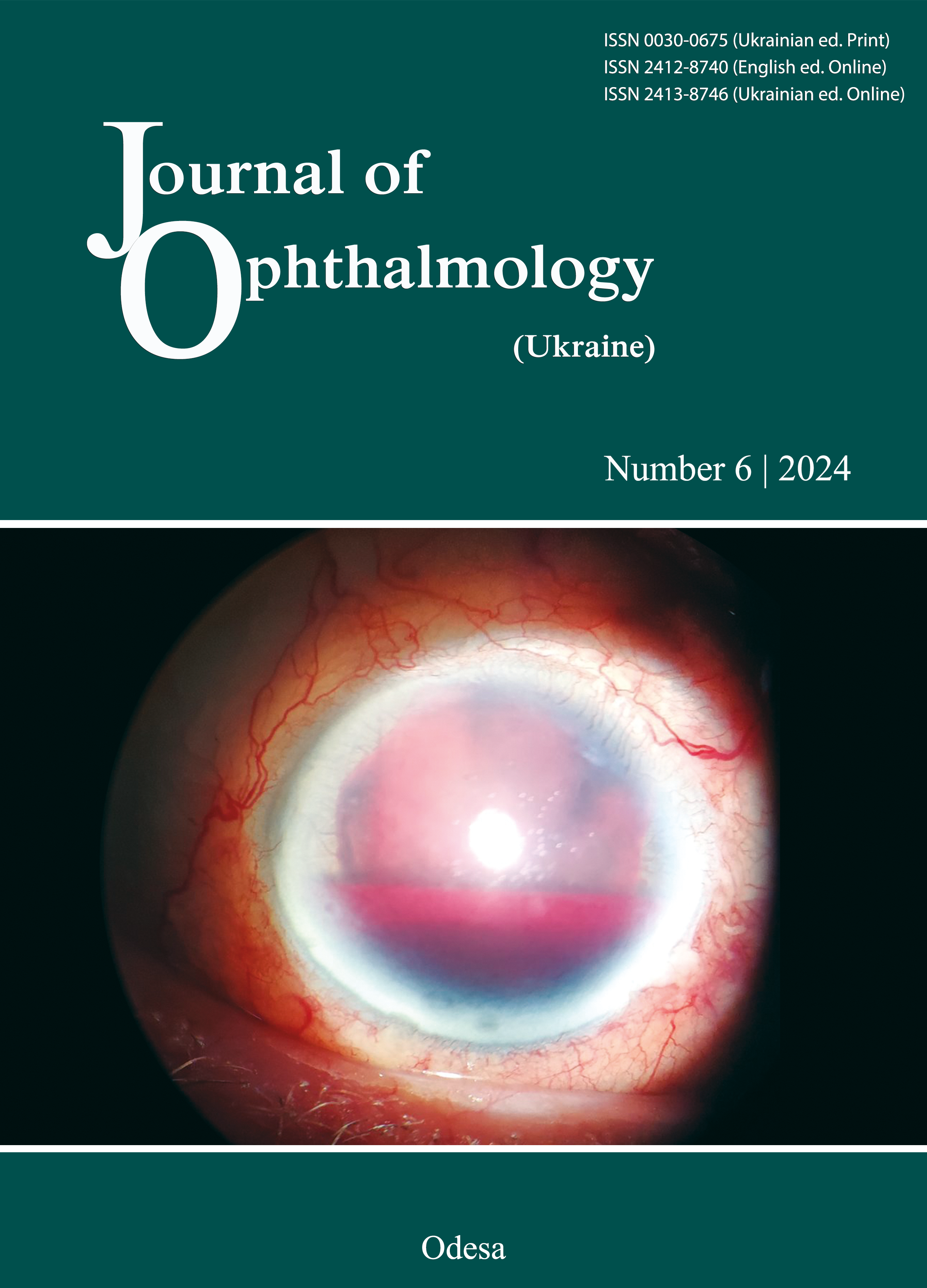Current interdisciplinary approaches to the diagnosis of stress-related disorders: designing a study and developing the protocol for an experiment with the EyeLink 1000 Plus eye tracker
DOI:
https://doi.org/10.31288/oftalmolzh202464047Abstract
Purpose: First, to develop a combination design for a psychodiagnostic study with the formation of two experimental groups, individuals with and without stress-related disorders (SRD), and, second, to develop a design and protocol for a study that will use the EyeLink 1000 Plus eye tracker for recording eye movement parameters and assessing pupil size.
Methods: The EyeLink 1000 Plus eye tracker provides highly accurate recording with a wide field of view at up to 2000 Hz. The experiment protocol includes the prosaccade task to assess the saccade latency, fixation duration, peak saccade velocity, and error rate. Screening psychodiagnostic questionnaires (the OPANA, IMZ-38 and PCL-5) and valid professional psychodiagnostic methods of Integral Instrumental Psychodynamic Diagnosis (IIPD) technology are used to form the experimental groups. Data Viewer software (SR Research) qre used for analysis of the gaze data recorded with the eye tracker.
Results: We developed a combination design for a psychodiagnostic study with the formation of two experimental groups, individuals with and without SRD. In addition, we developed a detailed design for an interdisciplinary study aiming to examine eye movement parameters in the context of SRD verified by professional psychodiagnosis tools. The protocol proposed integrates the prosaccade paradigm and current eye-tracking technology, providing objective measurements and standardized conditions for the experiment.
Conclusion: Conducting a study according to the design and protocol developed on the basis of an interdisciplinary approach with the use of current eye-tracking technology and psychodiagnostic methods creates the conditions for better understanding of stress-related cognitive and emotional processes, and can be useful for providing a rationale for new objective instrumental methods for the diagnosis of SRD.
References
Kessler RC, Petukhova M, Sampson NA, Zaslavsky AM, Wittchen HU. Twelve-month and lifetime prevalence and lifetime morbid risk of anxiety and mood disorders in the United States. Int J Methods Psychiatr Res. 2012;21(3):169-184. https://doi.org/10.1002/mpr.1359
Armstrong T, Olatunji BO. Eye tracking of attention in the affective disorders: a meta-analytic review and synthesis. Clin Psychol Rev. 2012;32(8):704-723. https://doi.org/10.1016/j.cpr.2012.09.004
Sears CR, Newman KR, Ference JD, et al. Attention to Emotional Images in Previously Depressed Individuals: An Eye-Tracking Study. Cogn Ther Res. 2011;35:517-28. https://doi.org/10.1007/s10608-011-9396-5
Klimanska M, Haletska I. Psychometric characteristics of the questionnaire on positive and negative affects (OPANA), based on the panas scales. Psychological journal. 2020;6(4):119-32. https://doi.org/10.31108/1.2020.6.4.10
Fokin AS. [Adaptation of mental health assessment scales]. Habitus. 2024;65:202-208. Ukrainian. https://doi.org/10.32782/2663-5208.2024.65.35
Veit CT, Ware JE Jr. The structure of psychological distress and well-being in general populations. J Consult Clin Psychol. 1983;51(5):730-742. https://doi.org/10.1037//0022-006X.51.5.730
Bezsheiko V. [Adapting the Clinician-Administered PTSD Scale for DSM-5 and PRSD Checklist for DSM-5 for the Ukrainian population]. Psychosomatychna medytsyna ta zagalna praktika. 19, Sept 2016 [cited 20, Nov 2024];1(1):e010108. Available from: https://uk.e-medjournal.com/index.php/psp/article/view/8
Emal LM, Tamminga SJ, Kezic S, Schaafsma FG, Nieuwenhuijsen K, van der Molen HF. Diagnostic Accuracy and Measurement Properties of Instruments Screening for Psychological Distress in Healthcare Workers-A Systematic Review. Int J Environ Res Public Health. 2023;20(12):6114. Published 2023 Jun 13. https://doi.org/10.3390/ijerph20126114
Vasylchenko O, Zhdanova T. [Technological and psychodymamic approach to the assessment of the psychological state: opportunities and prospects]. Vcheni zapysky universitetu KROK. 2024;1 (73):260-274. Ukrainian. https://doi.org/10.31732/2663-2209-2024-73-260-274
Rodina NV. [Psychology of Coping Behavior: System Simulation]. [Abstract of Dr Sc (Psychology) Dissertation]. Shevchenko National University of Kyiv; 2013. Ukrainian.
Biron BV. [Proactive coping with stressful situations]. [Abstract of Cand Sc (Psychology) Thesis]. Odesa: Mechnikov National University; 2015. Ukrainian.
Hutton SB. Cognitive control of saccadic eye movements. Brain Cogn. 2008;68(3):327-340. https://doi.org/10.1016/j.bandc.2008.08.021
Munoz DP, Everling S. Look away: the anti-saccade task and the voluntary control of eye movement. Nat Rev Neurosci. 2004;5(3):218-228. https://doi.org/10.1038/nrn1345
Fischer B, Weber H. Express saccades and visual attention. Behavioral and Brain Sciences. 1993;16(3):553-567. https://doi.org/10.1017/S0140525X00031575
Bardeen JR, Daniel TA. An Eye-Tracking Examination of Emotion Regulation, Attentional Bias, and Pupillary Response to Threat Stimuli. Cogn Ther Res. 2007; 41(6):853-66. https://doi.org/10.1007/s10608-017-9860-y
Downloads
Published
How to Cite
Issue
Section
License
Copyright (c) 2024 Zborovska O., Rodina N, Dorokhova O., Kolesnichenko V., Ambartsumian V.

This work is licensed under a Creative Commons Attribution 4.0 International License.
This work is licensed under a Creative Commons Attribution 4.0 International (CC BY 4.0) that allows users to read, download, copy, distribute, print, search, or link to the full texts of the articles, or use them for any other lawful purpose, without asking prior permission from the publisher or the author as long as they cite the source.
COPYRIGHT NOTICE
Authors who publish in this journal agree to the following terms:
- Authors hold copyright immediately after publication of their works and retain publishing rights without any restrictions.
- The copyright commencement date complies the publication date of the issue, where the article is included in.
DEPOSIT POLICY
- Authors are permitted and encouraged to post their work online (e.g., in institutional repositories or on their website) during the editorial process, as it can lead to productive exchanges, as well as earlier and greater citation of published work.
- Authors are able to enter into separate, additional contractual arrangements for the non-exclusive distribution of the journal's published version of the work with an acknowledgement of its initial publication in this journal.
- Post-print (post-refereeing manuscript version) and publisher's PDF-version self-archiving is allowed.
- Archiving the pre-print (pre-refereeing manuscript version) not allowed.












